The Women at the Head of the CLAS by Deborah Hyman
- Seven woman crew works to finish Hall B drift chambers
CLAS Facts
Festival of Science on Track for April 29th
Cool Choice by Tonya Short, Director's Office Intern
- Engineer works to keep accelerator cold
- Spring shopping trip in the works
- Picnic date set for May 13th
- Student named national finalist
- Fellowship winners announced
- Lawson selected for DOE council
- Hall A
- Hall B
- Hall C
Sugar, Spice, and Lots of Smarts
- Plans made at CEBAF for national "Take Our Daughters to Work Day"
The Women at the Head of the CLAS
Squinting helps. But it takes the eyes of an eagle-or an all woman crew-to see the wire being strung through the drift chambers for Hall B. One-by-one they feed a thin golden strand of wire into a microscopic opening no wider than the point of a pin.
"Patience," says Elsa Adrian, "is the key to working in here."
When the project is completed, seven women will have contributed to building one of the biggest, most complicated detectors in the world-the CEBAF Large Acceptance Spectrometer, or CLAS.
 Michelle Brisiel uses a meter to test each of the wires strung into one of the Region III drift chambers in the clean room in the Experimental Equipment Laboratory at CEBAF
Michelle Brisiel uses a meter to test each of the wires strung into one of the Region III drift chambers in the clean room in the Experimental Equipment Laboratory at CEBAF
Glance into the window of the Experimental Equipment Laboratory (EEL) clean room, and see figures cloaked in white robes, hair nets and gloves working on huge structures. At first glance, they look androgynous. Take a closer look, and realize the figures are all women.
"This is no glamorous job," says Adrian, who worked at Cornell University stringing drift chambers for 14 years before coming to CEBAF three years ago. "You can't be afraid of hard work."
The crew is responsible for completing six of the large Region III drift chambers and two of the medium-sized Region II chambers. So far, three are ready.
All In A Day's Work
The process begins when a new chamber full of small holes enters the clean room. The crew will go through an intricate procedure of filling the holes with wires, which will later detect charged particles during Hall B experiments.
First, the women glue hollow plastic tubes into the holes. Throughout the process, the crew works in teams of two performing different functions. The team assigned to this task will spend two weeks on the "Love Boat," or the two-story platform that sets them above the drift chamber. One glues the end of each tube and passes it to her kneeling partner who reaches out to the chamber to put the tube into place.
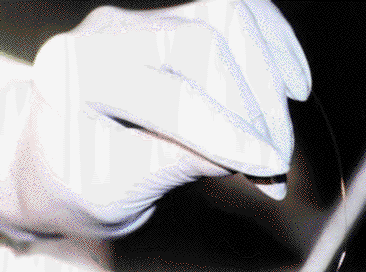 While still very thin, the gold-plated aluminum wire is actually wider than the gold-plated tungsten wire used on the CLAS drift chambers for Hall B.
While still very thin, the gold-plated aluminum wire is actually wider than the gold-plated tungsten wire used on the CLAS drift chambers for Hall B.
Now it's time to fill the chamber with three types of wire. The thinnest, the sense wire, is made of gold-plated tungsten and is hooked to amplifiers which produce signals allowing charged particles to be tracked. The field wire, of gold-plated aluminum, provides an electrical field for the sense wire. The guard wire, also of gold-plated tungsten (just thicker) smooths the electrical field distribution.
They begin with one person standing on a platform positioned near the top side of the chamber. She feeds the wire into a tiny cylinder, attaches an anchor to it (in this case, a needle on the end of a gold necklace is used because of its weight, visibility, and flexibility), then uses a motor to lower it through a hole in the side of the chamber. The person at the bottom of the chamber inserts a magnet into the corresponding hole below to attract the needle. She pulls the wire through, cuts off the chain, threads the wire through a pin, then crimps it to keep the wire tight.
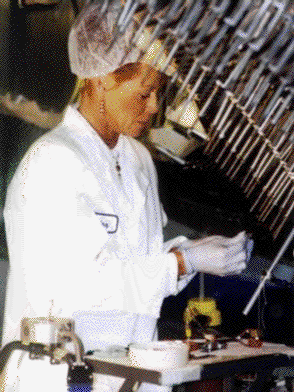 Linda Crockett strings the wire into a pin before crimping it tight
Linda Crockett strings the wire into a pin before crimping it tight
This process is done over and over again-about 9,000 times-for each chamber. And that's only if none of the wires get tangled or broken. If this occurs, the women can only describe fixing the problem as being "a pain in the neck," since retrieving it could lead to harming even more wires.
The workers recheck everything-visually and by computer. They test each wire with a voltmeter to make sure it's not touching its neighbor. Then they must make tension measurements. This involves locating and activating a large magnetic coil, then adjusting the frequency of a current being passed through the wire until the output pattern on the oscilloscope reveals that the wire is vibrating at proper frequency. If the tension differs from ideal by more than 10 percent, the wire is removed and replaced.
Once the structure is found to be fault free, each pin is glued to seal gas leaks and wrapped with a wire chain.
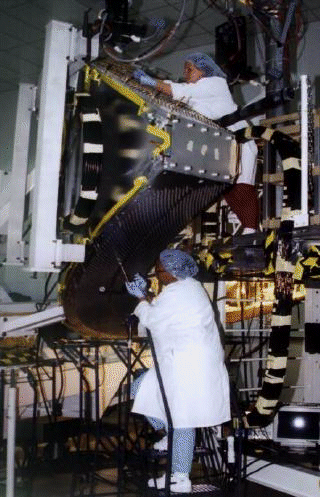 Debbie Cumbia (top) and Denise Roberts (bottom) work to complete one of the drift chambers in record time.
Debbie Cumbia (top) and Denise Roberts (bottom) work to complete one of the drift chambers in record time.
While the building process can be tedious, the women set daily goals to keep themselves moving at a quick pace. Teammates Adrian and Michelle Brisiel boast of their record stringing 315 wires in one day. "About two minutes per wire," says Adrian. "That may be the fastest in the world." Each chamber takes four and a half to five months to complete. Adrian has set a goal for the crew to finish one in less than four months.
"Just a year ago, there were no wires strung in any of the chambers. To date, they have strung more than 30,000 wires," says Mac Mestayer, overseer of the drift chamber project. "They do an extraordinary job and deserve a lot of credit. We rely on them a lot."
Doing What It Takes
Some days, the crew says the stress level is high. Looking in from the outside, all would still appear to be calm.
"You don't know what our job entails until you actually come into this room," says Linda Crockett, who has been at CEBAF for three years, but in the clean room six months. (She's also a bodybuilder who will soon begin training for the "women over 40" competition.)
Many factors seem to play into the stress: Deadlines, standing or kneeling all day, repetition, peering at the tiny wires, and feeding the wires into place.
"Sometimes, this is harder than pulling heavy cables," says Denise Roberts, who worked with cables in Hall C for a few years before coming to the clean room. "It is physically demanding."
Five to 10 times per day the technicians must also manually adjust their work platforms and the drift chambers to continue their work comfortably. The area of chamber being worked on has to be vertically aligned to properly feed the wires to the other side. Since the structure is curved, adjusting it is frequently necessary.
At this point, the atmosphere changes from one of calm to that of a noisy construction site.
Two technicians climb up opposite sides of a work platform to twist pins out, while two more crank the come-along or winch on the side to adjust the level. After ten minutes of cranking, twisting and climbing, the platform is readjusted and the crew resumes their work.
Just Like Family
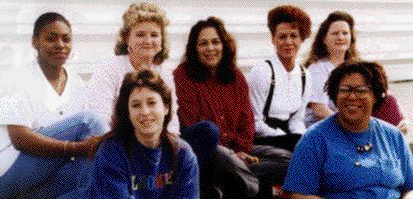 The seven woman crew takes a moment to pose for a group photo. They are (left to right) Front: Michelle Brisiel and Denise Roberts; Back: Wanda Griffin, Elaine Moss, Elsa Adrian, Linda Crockett and Debbie Cumbia.
The seven woman crew takes a moment to pose for a group photo. They are (left to right) Front: Michelle Brisiel and Denise Roberts; Back: Wanda Griffin, Elaine Moss, Elsa Adrian, Linda Crockett and Debbie Cumbia.
They say they are like a family and describe themselves as patient and devoted to their jobs.
Elaine Moss, whom they call the "angel of the chambers" (because she's the most patient of them all) says the crew started working together in the Accelerator Division's cable shop, formerly located on Blue Crab Road. Each was later transferred to the Physics division working in various electronics positions before going to the clean room. Wanda Griffin and Adrian are the only exceptions. Griffin is the newest member of the crew, coming to CEBAF only three months ago from the U.S. Post Office.
"We're all very supportive of each other," says Moss.
"And we're very dedicated to our jobs," adds Cumbia. "We just want the rest of the lab to see us as multi-talented."
Steve Christo, who oversees the drift chamber construction, adds "There are few workers with the diversity of skills and patience that we require in the construction of our drift chambers. The women in the clean room have no problem switching from moving two ton pieces of equipment to manipulating wire smaller than a human hair. Above all their craftsmanship is outstanding. We're very lucky to have them with us."
Deborah Hyman
CLAS Facts
Parts of the CEBAF Large Acceptance Spectrometer, or CLAS, are being fabricated in the Experimental Equipment Laboratory, or EEL building, located between CEBAF Center and the Test Lab.
There are a total of 18 drift chambers-six each of three sizes. CEBAF is building the six largest chambers (Region III) and two of the medium-sized chambers (Region II). Old Dominion University will build four Region II chambers. Carnegie Mellon University and the University of Pittsburgh will build the six Region I chambers.
These sections will ultimately be pieced together to detect charged particles.
The design, described as "complicated," was created by a group of CEBAF Hall B scientists, engineers and designers
Festival of Science on track for April 29th
It's almost time for CEBAF's Festival of Science-marking the end of construction and the beginning of science.
Many activities are planned, including hands-on activities, a tour of Hall B, a new CEBAF video, physics and technology transfer displays, a CEBAF quiz show, and the ever-popular cryogenics show.
Volunteers are still needed in all areas, including children's activity helpers, souvenir sales, information booth helpers and bus stop monitors, to make the event a success.
Your help is also needed to help spread the word of the event. If you need flyers to give to friends, family, or organizations, they are available in the Director's Office.
To volunteer, call Deborah Hyman at ext. 4852. See you at the festival!
COOL CHOICE
Engineer works to keep accelerator cold
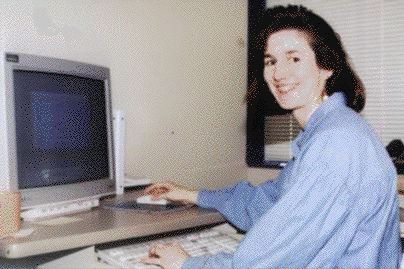 If you don't know Marie Keesee, then maybe you should. She is a staff engineer working in operations and system control with the Cryogenics System Group. The group is responsible for the design and operation of the cryogenics systems.
If you don't know Marie Keesee, then maybe you should. She is a staff engineer working in operations and system control with the Cryogenics System Group. The group is responsible for the design and operation of the cryogenics systems.
Keesee's position is extremely important, because without the efficient maintenance and control of the cryogenics system, the accelerator could not perform properly. And that would mean CEBAF could not accomplish its scientific mission.
Currently, Keesee is on loan to the Accelerator Controls Group to become familiar with EPICS (Experimental Physics and Industrial Control System), a new control system that runs the accelerator. Keesee is in the process of converting the Cryogenics Control System to EPICS.
"Without the cryogenic system, the accelerator can't operate." As a cryogenics coordinator, "I take turns being on call because the accelerator runs 24-hours-a-day," says Keesee.
In addition to her duties at CEBAF, Keesee is taking Computer Science courses at Old Dominion University.
Keesee says she feels unique in her field. "When you are a female engineer everyone knows who you are, because you are in a male-dominated field. At some engineering conferences, out of 700 attendees, about 10 percent are women."
Keesee says she was fortunate to have been exposed to science at a young age. Her father and older brother are both physicists. Her father works at Fermi National Accelerator Laboratory in Illinois where Keesee worked as an intern.
"I've been working in a laboratory since I was 16. It gave me the opportunity to work with engineers and became familiar with the field early," she says. "The problem for a lot of girls is that they don't get that early exposure to technical fields."
Keesee stresses the importance of programs designed to help women determine their career paths at an early age. "If I hadn't had the opportunity to work in engineering programs I might not have chosen this field. That's why I like what CEBAF does with its programs for kids."
Upon graduating from Marquette University in Wisconsin with a degree in Electrical Engineering, Keesee was hired as a staff engineer at CEBAF in 1987.
Keesee's advice to young women is: "If you can, get some type of summer job. You have to actually work in the field to see if it is what you want to do for the rest of your life." Having an internship also "helps you get a job afterwards, because you will have the experience."
Tonya Short, Director's Office Intern
Employee Recreation Update
Spring shopping trip in the works
Hey all of you "blue light shoppers!" The Recreation Committee is planning a trip to Potomac Mills, a large outlet shopping mall in Northern Virginia on June 3. A small fee of $15 (with a 40 person minimum) guarantees a bus ride there and back. The bus will pull out of CEBAF around 7 a.m. and return later that night.
Friends and family are welcome to join us. Let us know if you're interested by calling Delores Thomas at ext. 7182.
Picnic date set for May 13th
Jurassic Park it's not. And a good thing, too. Newport News Park, the site of the 1995 CEBAF Family Picnic, has picnic tables, grills, trees, trails, even volleyball nets, but no tyrannosaurus rexes.
Grab your shorts, your kids, your spouse and your spirit of fun, and come on out, Saturday May 13, for a day of food, fun, games and goofing off. From 10 a.m. to 3 p.m. we'll have plenty of eats and activities for kids of all ages. Entertainment includes softball (balls and bats provided; bring your own gloves), volleyball and badminton. There'll be a moonwalk for the kids, along with a clown, face-painting and more.
The list of food provided by CEBAF reads like Paul Bunyan's shopping list: burgers, hot dogs, buns, chicken, sausage, baked beans, condiments, soft drinks, popcorn, cotton candy and sno-cones. But we know how nice it is to be needed, so YOU get to bring salads, side dishes, desserts, chips and dips. We're also counting on you to show up with energy, enthusiasm and appetites, ready to have fun.
Perfect picnics take planning, so let us know that you're coming, and how many family members you're bringing along. That way we can make sure there's plenty of food on hand. Everyone in the CEBAF family is invited to this day of play. Come let off steam or kick back, make new friends or catch up with old ones; take your pick.
Fill out the response form below and return it to CEBAF Center desk or Staff Services MS-12G.
No pets, please. This is a necessary safety measure, because of all the children. And sorry, no dinosaurs.
If you have suggestions or comments regarding recreation at CEBAF, please leave them in the e-mail suggestion box at rec_comm@jlab.org or call Deborah Hyman, Employee Recreation Committee Chair at ext. 4852.
Briefly...
Student named national finalist
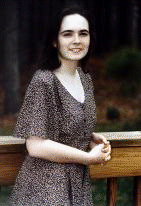 Kari Heffner, a student in the User Liaison office was recently chosen as a National Merit Scholarship (NMS) Finalist. Heffner is a student at Bethel High School in Hampton, and was picked out of thousands of students based on her scholarly achievement on her PSAT and SAT test scores, which were 1510 and 1440 respectively. The NMS will pick 2000 students to receive a $2000 scholarship. "I'm not there yet but I'm hoping, says Heffner." She was recently accepted to MIT and the University of Virginia and hopes to study physics. Heffner will also be the valedictorian of her graduating class. Congratulations Kari!
Kari Heffner, a student in the User Liaison office was recently chosen as a National Merit Scholarship (NMS) Finalist. Heffner is a student at Bethel High School in Hampton, and was picked out of thousands of students based on her scholarly achievement on her PSAT and SAT test scores, which were 1510 and 1440 respectively. The NMS will pick 2000 students to receive a $2000 scholarship. "I'm not there yet but I'm hoping, says Heffner." She was recently accepted to MIT and the University of Virginia and hopes to study physics. Heffner will also be the valedictorian of her graduating class. Congratulations Kari!
Fellowship winners announced
Five awardees were announced for the SURA/CEBAF Graduate Fellowship program now in its seventh year. They are: Christopher Armstrong, Nuclear Hadronic Physics, the College of William and Mary; Alina Cichocki, Experimental Nuclear Physics, University of Virginia; Christopher Cothran, Particle Physics, University of Virginia; Ji Li, Nuclear Theory, Vanderbilt University; and Richard Mohring, Experimental Nuclear Physics, the University of Maryland.
Fellows will receive $12,750 each for the nine month academic year. In addition, awardees will be eligible for summer employment at CEBAF and will receive a stipend for travel to CEBAF for research and training.
Fellowship applications were evaluated based on their academic qualifications; merit and quality of proposed research; utility or relevance of proposed research to CEBAF and proposed utilization of research resources at CEBAF; and the likelihood that the proposed study will accomplish defined research objectives by graduation.
The review committee was comprised of Larry Cardman (Physics), Chairman Carey Stronach (Virginia State University), and J. Wallace Van Orden (Old Dominion University). Since 1989 the program has made 31 awards totaling more than $360,000 to promising graduate students at SURA member institutions.
Lawson selected for DOE council
Elizabeth Lawson, division administrator and Quality Assurance Officer for the Administration Division, was recently selected to serve a two year term on the Department of Energy Quality Council.
"Participation on the DOE Quality Council will bring about a better understanding of the environment in which CEBAF is a part," says Lawson. "It is important that DOE and CEBAF, as partners, understand each other so that our decisions are made with the best possible information. The whole quality initiative is simply an enabler of this enhanced awareness."
The 28-member council was formed to design the approach for implementing DOE's quality initiative, establish conceptual framework and become a driving force for quality improvement leading to DOE as being"best in class." The council will address awards and recognition, metrics, outreach and communications, as well as a quality action plan. CEBAF Associate Director for Technical Performance, Ron Sundelin, has been a member from the beginning and now is a member representing the Three-Point Program Committee.
Experimental Halls Update
The experimental halls are filling quickly. New equipment has been installed in each hall and major accomplishments have been made since the last update in the January edition of CEBAF News. Following is a brief update:
Hall A
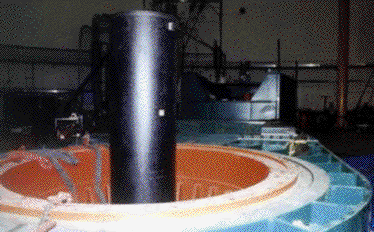 Pictured is the central bearing for the two high resolution spectrometers in Hall A.
Pictured is the central bearing for the two high resolution spectrometers in Hall A.
Work continues on the assembly and installation of both high resolution spectrometers in Hall A. The assembled dipole magnet for the electron arm is now in position for acceptance tests. This superconducting magnet achieved 1800 amps recently, exceeding magnetic field requirements.
The cradle link for the hadron arm is now in the hall being prepared for installation. The first of five vertical drift chambers for the detector system were received from the MIT collaboration. The University of Maryland group is making progress with the detector space frame. They have already delivered the frames for the shower counters.
An operational safety review of the Hall A magnet systems was held at CEBAF last week. Representatives from industry, outside consultants, and CEBAF staff members participated.
Hall B
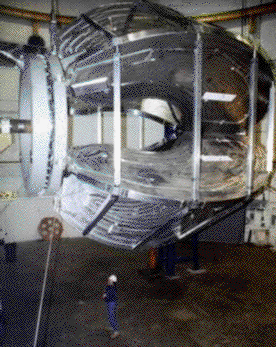 (Figure 1) The toroidal magnet for thhe CEBAF Large Acceptance Spectrometer.
(Figure 1) The toroidal magnet for thhe CEBAF Large Acceptance Spectrometer.
Hall B is the home of a toroidal multi-gap magnetic spectrometer called the CEBAF Large Acceptance Spectrometer, or CLAS. A toroidal magnet (Figure 1) provides the bending power for the momentum analysis of charged particles. The magnetic field is generated by six superconducting coils with a total current of 5 million ampere-turns. Each of the six coils is contained in its own cryostat with a common support ring in the back. Cooling of the magnet is provided by the end station refrigerator (ESR) via a straight helium transfer line.
Following a reference design produced by the Hall B engineering group the vendor, Oxford Instruments (Great Britain), finalized the design, fabricated and tested all coils and cryostats. The coils were transported to CEBAF in October 1994, and the Oxford Instruments team started the final assembly of the coils.
On March 22, 1995 at 12:15 p.m. the CLAS superconducting toroidal magnet reached full field at the design current of 3,861 amps. This achievement represents a major milestone on the road to the completion of the Hall B equipment.
Hall C
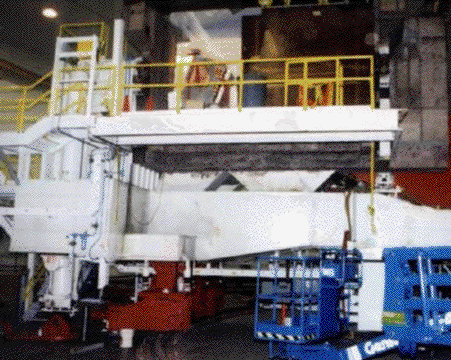 The Short Orbit Spectrometer (SOS) in Hall C is near completion.
The Short Orbit Spectrometer (SOS) in Hall C is near completion.
Hall C has two spectrometers: The high momentum spectrometer (HMS), and the short orbit spectrometer (SOS). The HMS is operational, while the SOS is nearing completion. Several detectors (two hodoscopes and two drift chambers) have been installed in the SOS detector hut. The SOS will be used during experiments to detect particles with short decay time.
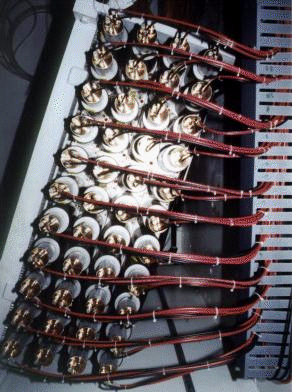
In the back of the SOS are photomultipliers of the lead glass counter arrangement which will serve to identify particles during experiments. They were built by Armenian collaborators.
Hall C is awaiting beam so they can begin commissioning of the SOS. They are also planning to put the two spectrometers in coincidence (working together looking at the same interactions) for a test of this capability as soon as this month's run begins.
Sugar, Spice, and Lots of Smarts
Plans made at CEBAF for national "Take Our Daughters to Work Day"
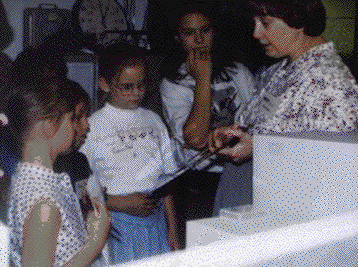 Rita Chambers explain how a computer hard disk is used. Chambers was just one of many CEBAF employees who volunteered to help during Take Our Daughters To Work Day last year.
Rita Chambers explain how a computer hard disk is used. Chambers was just one of many CEBAF employees who volunteered to help during Take Our Daughters To Work Day last year.
April 27, 1995 marks the official Third Annual "Take Our Daughters to Work Day." Last year, CEBAF joined more than 25 million people around the country in bringing girls aged 9-15 years into the workplace. Research shows that girls approach their teen years with confidence and enthusiasm-then at adolescence girls experience some disturbing and unhealthy changes.
Adolescent girls tend to have lower expectations for their future than boys do. In keeping alive the spirit of achievement and the level of confidence and enthusiasm alive in our daughters (or friends' or neighbors' daughters), CEBAF is providing an opportunity to show them the exciting science being done at CEBAF and the career opportunities available to women.
CEBAF will be providing tours, hands-on activities, and speakers for visiting girls. Last year's event enticed nearly 40 girls to visit CEBAF. Volunteers are still needed to help with the activities. For more information please contact Claire Jacobs at 7538.
CEBAF hockey night a success!
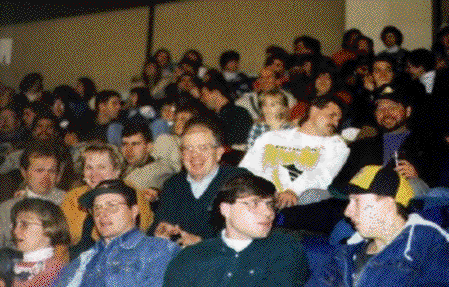 Seventy-five CEBAF employees and their families enjoyed a night of hockey recently with the Admirals pitted against the Richmond Renegades. The Admirals won 3-2 in front of a sold-out crowd. The event was the first of its kind orgranized by the CEBAF Recreation Committee. Look for flyers announcing sign-up for the Tides baseball game in June!
Seventy-five CEBAF employees and their families enjoyed a night of hockey recently with the Admirals pitted against the Richmond Renegades. The Admirals won 3-2 in front of a sold-out crowd. The event was the first of its kind orgranized by the CEBAF Recreation Committee. Look for flyers announcing sign-up for the Tides baseball game in June!

